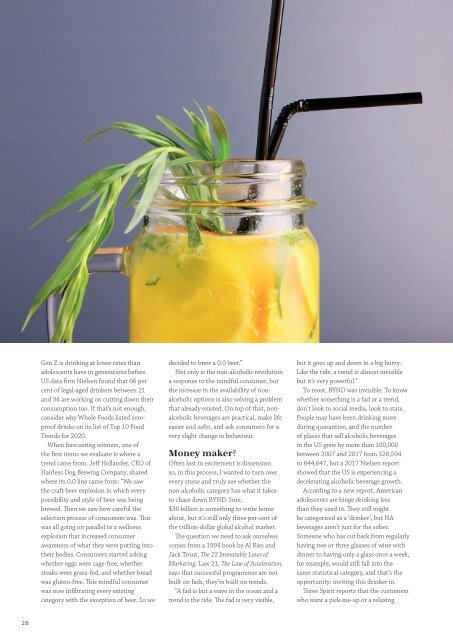THE ZONE
A wellbeing publication for businesses wanting to tell their wellbeing story. Produced by national journalists we provide in-depth features on everything you need to engage your staff regarding wellbeing at work, from our environment to physical and mental wellbeing. In every issue, we feature a people story, a workspace story, an interview with a leading figure in wellbeing as well as nutrition, self development, and exercise - and we cover all the latest trends in our news pages. The unique offering allows each company to own their content with bespoke pages where you can share staff news, your wellbeing diary and your vision - as well as your company logo on the cover. We aim to inspire, and encourage all our readers to always see the bigger picture.
A wellbeing publication for businesses wanting to tell their wellbeing story. Produced by national journalists we provide in-depth features on everything you need to engage your staff regarding wellbeing at work, from our environment to physical and mental wellbeing. In every issue, we feature a people story, a workspace story, an interview with a leading figure in wellbeing as well as nutrition, self development, and exercise - and we cover all the latest trends in our news pages. The unique offering allows each company to own their content with bespoke pages where you can share staff news, your wellbeing diary and your vision - as well as your company logo on the cover. We aim to inspire, and encourage all our readers to always see the bigger picture.
Create successful ePaper yourself
Turn your PDF publications into a flip-book with our unique Google optimized e-Paper software.
Gen Z is drinking at lower rates than<br />
adolescents have in generations before.<br />
US data firm Nielsen found that 66 per<br />
cent of legal-aged drinkers between 21<br />
and 34 are working on cutting down their<br />
consumption too. If that’s not enough,<br />
consider why Whole Foods listed zeroproof<br />
drinks on its list of Top 10 Food<br />
Trends for 2020.<br />
When forecasting winners, one of<br />
the first items we evaluate is where a<br />
trend came from. Jeff Hollander, CEO of<br />
Hairless Dog Brewing Company, shared<br />
where its 0.0 line came from: “We saw<br />
the craft beer explosion in which every<br />
possibility and style of beer was being<br />
brewed. Then we saw how careful the<br />
selection process of consumers was. This<br />
was all going on parallel to a wellness<br />
explosion that increased consumer<br />
awareness of what they were putting into<br />
their bodies. Consumers started asking<br />
whether eggs were cage-free, whether<br />
steaks were grass-fed, and whether bread<br />
was gluten-free. This mindful consumer<br />
was now infiltrating every existing<br />
category with the exception of beer. So we<br />
decided to brew a 0.0 beer.”<br />
Not only is the non-alcoholic revolution<br />
a response to the mindful consumer, but<br />
the increase in the availability of nonalcoholic<br />
options is also solving a problem<br />
that already existed. On top of that, nonalcoholic<br />
beverages are practical, make life<br />
easier and safer, and ask consumers for a<br />
very slight change in behaviour.<br />
Money maker?<br />
Often lost in excitement is dissension<br />
so, in this process, I wanted to turn over<br />
every stone and truly see whether the<br />
non-alcoholic category has what it takes<br />
to chase down BYND. Sure,<br />
$30 billion is something to write home<br />
about, but it’s still only three per cent of<br />
the trillion-dollar global alcohol market.<br />
The question we need to ask ourselves<br />
comes from a 1994 book by Al Ries and<br />
Jack Trout, The 22 Immutable Laws of<br />
Marketing. Law 21, The Law of Acceleration,<br />
says that successful programmes are not<br />
built on fads, they’re built on trends.<br />
“A fad is but a wave in the ocean and a<br />
trend is the tide. The fad is very visible,<br />
but it goes up and down in a big hurry.<br />
Like the tide, a trend is almost invisible<br />
but it’s very powerful.”<br />
To most, BYND was invisible. To know<br />
whether something is a fad or a trend,<br />
don’t look to social media, look to stats.<br />
People may have been drinking more<br />
during quarantine, and the number<br />
of places that sell alcoholic beverages<br />
in the US grew by more than 100,000<br />
between 2007 and 2017 from 528,594<br />
to 644,647, but a 2017 Nielsen report<br />
showed that the US is experiencing a<br />
decelerating alcoholic beverage growth.<br />
According to a new report, American<br />
adolescents are binge drinking less<br />
than they used to. They still might<br />
be categorised as a ‘drinker’, but NA<br />
beverages aren’t just for the sober.<br />
Someone who has cut back from regularly<br />
having two or three glasses of wine with<br />
dinner to having only a glass once a week,<br />
for example, would still fall into the<br />
same statistical category, and that’s the<br />
opportunity: inviting this drinker in.<br />
Three Spirit reports that the customers<br />
who want a pick-me-up or a relaxing<br />
28<br />
26-30_World of wellbeing_Alcohol (Final).indd 3 20/07/2020 17:45




